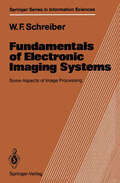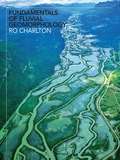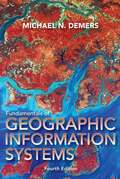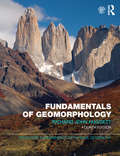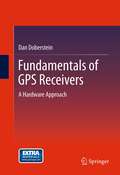- Table View
- List View
Fundamentals of Cosmic Electrodynamics (Astrophysics and Space Science Library #191)
by B.V. SomovCosmic electrodynamics is the specific branch of plasma physics which studies electromagnetic phenomena -- mostly the role of electromagnetic forces in dynamics of highly-conducting compressible medium in the solar interior and atmosphere, solar wind, in the Earth's magnetosphere and magnetospheres of other planets as well as pulsars and other astrophysical objects. This textbook is written to be used at several different levels. It is aimed primarily at beginning graduate students who are assumed to have a knowledge of basic physics. Starting from the language of plasma physics, from Maxwell's equations, the author guides the reader into the more specialized concepts of cosmic electrodynamics. The main attention in the book is paid to physics rather than maths. However, the clear mathematical image of physical processes in space plasma is presented and spelled out in the surrounding text. There is not another way to work in modern astrophysics at the quantitative level. The book will also be useful for professional astronomers and for specialists, who investigate cosmic plasmas from space, as well as for everybody who is interested in modern astrophysics.
Fundamentals of Crystals: Symmetry, and Methods of Structural Crystallography
by Boris K. VainshteinFrom the reviews: "[...] an excellent reference book. I have no doubt it will become a much-thumbed resource for students and researchers in mineralogy and crystallography." Geological Magazine
Fundamentals of Deep Excavations
by Chang-Yu OuExcavation is an important segment of foundation engineering (e.g., in the construction of the foundations or basements of high-rise buildings, underground oil tanks, or subways). However, the excavation knowledge introduced in most books on foundation engineering is too simple to handle actual excavation analysis and design. Moreover, with economic development and urbanization, excavations go deeper and are larger in scale. These conditions require elaborate analysis, design methods and construction technologies. This book is aimed at both theoretical explication and practical application. From basic to advanced, this book attempts to achieve theoretical rigor and consistency. Each chapter is followed by a problem set so that the book can be readily taught at senior undergraduate and graduate levels. The solution to the problems at the end of the chapters can be found on the website (http://www.ct.ntust.edu.tw/ou/). On the other hand, the analysis methods introduced in the book can be used in actual analysis and design as they contain the most up-to-date knowledge. Therefore, this book is suitable for teachers who teach foundation engineering and/or deep excavation courses and engineers who are engaged in excavation analysis and design.
Fundamentals of Deep Excavations
by Chang-Yu OuExcavation is an important segment of foundation engineering (e.g., in the construction of the foundations or basements of high-rise buildings, underground oil tanks, or subways). However, the excavation knowledge introduced in most books on foundation engineering is too simple to handle actual excavation analysis and design. Moreover, with economic development and urbanization, excavations go deeper and are larger in scale. These conditions require elaborate analysis, design methods and construction technologies. This book is aimed at both theoretical explication and practical application. From basic to advanced, this book attempts to achieve theoretical rigor and consistency. Each chapter is followed by a problem set so that the book can be readily taught at senior undergraduate and graduate levels. The solution to the problems at the end of the chapters can be found on the website (http://www.ct.ntust.edu.tw/ou/). On the other hand, the analysis methods introduced in the book can be used in actual analysis and design as they contain the most up-to-date knowledge. Therefore, this book is suitable for teachers who teach foundation engineering and/or deep excavation courses and engineers who are engaged in excavation analysis and design.
The Fundamentals of Electron Density, Density Matrix and Density Functional Theory in Atoms, Molecules and the Solid State (Progress in Theoretical Chemistry and Physics #14)
by N. I. Gidopoulos Stephen WilsonThis volume records the proceedings of a Forum on The Fundamentals of Electron Density, Density Matrix and Density Functional Theory in Atoms, Molecules and the Solid State held at the Coseners' House, Abingdon-on-Thames, Oxon. over the period 31st May - 2nd June, 2002. The forum consisted of 26 oral and poster presentations followed by a discussion structure around questions and comments submitted by the participants (and others who had expressed an interest) in advance of the meeting. Quantum mechanics provides a theoretical foundation for our under standing of the structure and properties of atoms, molecules and the solid state in terms their component particles, electrons and nuclei. (Rel ativistic quantum mechanics is required for molecular systems contain ing heavy atoms.) However, the solution of the equations of quantum mechanics yields a function, a wave function, which depends on the co ordinates, both space and spin, of all of the particles in the system. This functions contains much more information than is required to yield the energy or other property.
Fundamentals of Electronic Imaging Systems: Some Aspects of Image Processing (Springer Series in Information Sciences #15)
by William F. SchreiberImage processing is an applications area. In this area there are many op portunities to apply art and experience, as well as knowledge from various sciences and engineering disciplines, to the creation of products and pro cesses for which society has urgent need. Without this need, few would be interested in the subject. This point of view motivates this work and has influenced the selection and treatment of topics. It will be noticed that the word "digital" is not in the title. While much of present-day image processing is implemented digitally, this work is not intended for those who think that image processing is a branch of digital signal processing, except perhaps to try to change their minds. This book grew out of courses taught at the Massachusetts Institute of Technology by the author and two of his former students, T.S. Huang and O.J. Tretiak. Like the courses, it is primarily intended for electrical engineers and computer scientists who plan to work in the field. It has not proven necessary to spend much time on strictly digital issues, since the students either know that material already or can learn it very easily by 1 themselves. It also has been unnecessary to be encyclopedic, since Pratt has already performed this important service.
Fundamentals of Environmental Law and Compliance
by Daniel T. RogersThis textbook provides readers with the fundamentals and the intent of environmental regulations so that compliance can be greatly improved and streamlined. Through numerous examples and case studies, it explains concepts from how environmental laws are applied and work to why pollution prevention and sustainability are critical for the future of all life on Earth. It is organized to accommodate different needs of students with different backgrounds and career choices. It is also useful for site safety and environmental managers, researchers, technicians, and other young professionals with a desire to apply environmental regulations and sustainability measures to their facilities and stay up to date on recently changed regulations. FEATURES Introduces students to issues of global environmental and sustainability challenges and policy Explains the science behind issues such as climate change, how environmental policy is made at the national and international levels, and what role politics play in determining environmental resource use Focuses on fundamental principles that are applicable in all nations and legal contexts Addresses the planet as one biosphere and briefly discusses environmental laws and regulations of more than 50 countries Provides numerous case studies that demonstrate major concepts and themes, examples, questions, and exercises to strengthen understanding and promote critical thinking, discussion, and debate This book will benefit students in advanced undergraduate and graduate programs in environmental sciences and environmental engineering. It will also be of use to new practitioners who are entering the field of environmental management and need an introduction to environmental regulations.
Fundamentals of Environmental Law and Compliance
by Daniel T. RogersThis textbook provides readers with the fundamentals and the intent of environmental regulations so that compliance can be greatly improved and streamlined. Through numerous examples and case studies, it explains concepts from how environmental laws are applied and work to why pollution prevention and sustainability are critical for the future of all life on Earth. It is organized to accommodate different needs of students with different backgrounds and career choices. It is also useful for site safety and environmental managers, researchers, technicians, and other young professionals with a desire to apply environmental regulations and sustainability measures to their facilities and stay up to date on recently changed regulations. FEATURES Introduces students to issues of global environmental and sustainability challenges and policy Explains the science behind issues such as climate change, how environmental policy is made at the national and international levels, and what role politics play in determining environmental resource use Focuses on fundamental principles that are applicable in all nations and legal contexts Addresses the planet as one biosphere and briefly discusses environmental laws and regulations of more than 50 countries Provides numerous case studies that demonstrate major concepts and themes, examples, questions, and exercises to strengthen understanding and promote critical thinking, discussion, and debate This book will benefit students in advanced undergraduate and graduate programs in environmental sciences and environmental engineering. It will also be of use to new practitioners who are entering the field of environmental management and need an introduction to environmental regulations.
Fundamentals of Estuarine Physical Oceanography (Ocean Engineering & Oceanography #8)
by Luiz Bruner de Miranda Fernando Pinheiro Andutta Björn Kjerfve Belmiro Mendes Castro FilhoThis book provides an introduction to the complex system functions, variability and human interference in ecosystem between the continent and the ocean. It focuses on circulation, transport and mixing of estuarine and coastal water masses, which is ultimately related to an understanding of the hydrographic and hydrodynamic characteristics (salinity, temperature, density and circulation), mixing processes (advection and diffusion), transport timescales such as the residence time and the exposure time.In the area of physical oceanography, experiments using these water bodies as a natural laboratory and interpreting their circulation and mixing processes using theoretical and semi-theoretical knowledge are of fundamental importance. Small-scale physical models may also be used together with analytical and numerical models. The book highlights the fact that research and theory are interactive, and the results provide the fundamentals for the development of the estuarine research.
Fundamentals of Fibre-Reinforced Soil Engineering (Developments in Geotechnical Engineering)
by Sanjay Kumar ShuklaThis book is intended to serve as a one-stop reference on fibre-reinforced soils. Over the past 30-35 years, the engineering behaviour of randomly distributed/oriented fibre-reinforced soil, also called simply fibre-reinforced soil, has been investigated in detail by researchers and engineers worldwide. Waste fibres (plastic waste fibres, old tyre fibres, etc.) create disposal and environmental problems. Utilization of such fibres in construction can help resolve these concerns. Research studies and some field applications have shown that the fibres can be utilized in large quantities in geotechnical and civil engineering applications in a cost-effective and environmentally friendly manner. This book covers a complete description of fibres, their effects when included within a soil or other similar materials such as the fly ash, and their field applications. It gives a detailed view of fibre-reinforced soil engineering. The book will be useful to students, professional, and researchers alike, and can also serve as a text for graduate coursework and professional development programs
Fundamentals of Fluvial Geomorphology
by Ro CharltonRivers are significant geomorphological agents, they show an amazing diversity of form and behaviour and transfer water and sediment from the land surface to the oceans. This book examines how river systems respond to environmental change and why this understanding is needed for successful river management. Highly dynamic in nature, river channels adjust and evolve over timescales that range from hours to tens of thousands of years or more, and are found in a wide range of environments. This book provides a comprehensive overview of recent developments in river channel management, clearly illustrating why an understanding of fluvial geomorphology is vital in channel preservation, environmentally sensitive design and the restoration of degraded river channels. It covers: flow and sediment regimes: flow generation; flow regimes; sediment sources, transfer and yield channel processes: flow characteristics; processes of erosion and sediment transport; interactions between flow and the channel boundary; deposition channel form and behaviour: controls on channel form; channel adjustments; floodplain development; form and behaviour of alluvial and bedrock channels response to change: how channels have responded to past environmental change; impacts of human activity; reconstructing past changes river management: the fluvial hydrosystem; environmental degradation; environmentally sensitive engineering techniques; river restoration; the role of the fluvial geomorphologist. Fundamentals of Fluvial Geomorphology is an indispensable text for undergraduate students. It provides straightforward explanations for important concepts and mathematical formulae, backed up with conceptual diagrams and appropriate examples from around the world to show what they actually mean and why they are important. A colour plate section also shows spectacular examples of fluvial diversity.
Fundamentals of Fluvial Geomorphology
by Ro CharltonRivers are significant geomorphological agents, they show an amazing diversity of form and behaviour and transfer water and sediment from the land surface to the oceans. This book examines how river systems respond to environmental change and why this understanding is needed for successful river management. Highly dynamic in nature, river channels adjust and evolve over timescales that range from hours to tens of thousands of years or more, and are found in a wide range of environments. This book provides a comprehensive overview of recent developments in river channel management, clearly illustrating why an understanding of fluvial geomorphology is vital in channel preservation, environmentally sensitive design and the restoration of degraded river channels. It covers: flow and sediment regimes: flow generation; flow regimes; sediment sources, transfer and yield channel processes: flow characteristics; processes of erosion and sediment transport; interactions between flow and the channel boundary; deposition channel form and behaviour: controls on channel form; channel adjustments; floodplain development; form and behaviour of alluvial and bedrock channels response to change: how channels have responded to past environmental change; impacts of human activity; reconstructing past changes river management: the fluvial hydrosystem; environmental degradation; environmentally sensitive engineering techniques; river restoration; the role of the fluvial geomorphologist. Fundamentals of Fluvial Geomorphology is an indispensable text for undergraduate students. It provides straightforward explanations for important concepts and mathematical formulae, backed up with conceptual diagrams and appropriate examples from around the world to show what they actually mean and why they are important. A colour plate section also shows spectacular examples of fluvial diversity.
Fundamentals of Foundation Engineering
by Chang-Yu Ou Kuo-Hsin Yang Fuchen Teng Jiunn-Shyang Chiou Chih-Wei Lu An-Jui Li Jianye Ching Jui-Tang LiaoThis book aims to introduce the principle and design of various foundations, covering shallow foundations, mat foundations, earth retaining structures, excavations, pile foundations, and slope stability. Since the analysis and design of a foundation are based on the soil properties under short-term (undrained) or long-term (drained) conditions, the assessment of soil properties from the geotechnical site investigation and the concept of drained or undrained soil properties are discussed in the first two chapters. Foundation elements transfer various load combinations from the superstructure to the underlying soils or rocks. The load transfer mechanisms, vertical stress or earth pressure distributions, and failure modes of each foundation type are clearly explained in this book. After understanding the soil responses subjected to the loadings from the foundation, the design methods, required factors of safety, and improvement measures for each foundation type are elaborated. This book presents both theoretical explication and practical applications for readers to easily comprehend the theoretical background, design methods, and practical applications and considerations. Each chapter provides relevant exercise examples and a problem set for self-practice. The analysis methods introduced in the book can be applied in actual analysis and design as they contain the most up-to-date knowledge of foundation design. This book is suitable for teachers and students to use in foundation engineering courses and engineers who are engaged in foundation design to create a technically sound, construction-feasible, and economical design of the foundation system.
Fundamentals of Foundation Engineering
by Chang-Yu Ou Kuo-Hsin Yang Fuchen Teng Jiunn-Shyang Chiou Chih-Wei Lu An-Jui Li Jianye Ching Jui-Tang LiaoThis book aims to introduce the principle and design of various foundations, covering shallow foundations, mat foundations, earth retaining structures, excavations, pile foundations, and slope stability. Since the analysis and design of a foundation are based on the soil properties under short-term (undrained) or long-term (drained) conditions, the assessment of soil properties from the geotechnical site investigation and the concept of drained or undrained soil properties are discussed in the first two chapters. Foundation elements transfer various load combinations from the superstructure to the underlying soils or rocks. The load transfer mechanisms, vertical stress or earth pressure distributions, and failure modes of each foundation type are clearly explained in this book. After understanding the soil responses subjected to the loadings from the foundation, the design methods, required factors of safety, and improvement measures for each foundation type are elaborated. This book presents both theoretical explication and practical applications for readers to easily comprehend the theoretical background, design methods, and practical applications and considerations. Each chapter provides relevant exercise examples and a problem set for self-practice. The analysis methods introduced in the book can be applied in actual analysis and design as they contain the most up-to-date knowledge of foundation design. This book is suitable for teachers and students to use in foundation engineering courses and engineers who are engaged in foundation design to create a technically sound, construction-feasible, and economical design of the foundation system.
Fundamentals of Geographic Information Systems
by Michael N. DeMersThe Fourth Edition of this well-received text on the principles of geographic information systems (GIS) continues the author's style of "straight talk" in its presentation and is written to be accessible and easy to follow. Unlike most other GIS texts, this book covers GIS design and modeling, reflecting the belief that modeling and analysis are at the heart of GIS. This approach helps students understand and use GIS technology.
Fundamentals of Geomorphology
by Richard John HuggettThe new fourth edition of Fundamentals of Geomorphology continues to provide a comprehensive introduction to the subject by discussing the latest developments in the field, as well as covering the basics of Earth surface forms and processes. The revised edition has an improved logically cohesive structure, added recent material on Quaternary environments and landscapes, landscape evolution and tectonics, as well as updated information in fast-changing areas such as the application of dating techniques, digital terrain modelling, historical contingency, preglacial landforms, neocatastrophism, and biogeomorphology. The book begins with a consideration of the nature of geomorphology, process and form, history, and geomorphic systems, and moves on to discuss: Endogenic processes: structural landforms associated with plate tectonics and those associated with volcanoes, impact craters, and folds, faults, and joints. Exogenic processes: landforms resulting from, or influenced by, the exogenic agencies of weathering, running water, flowing ice and meltwater, ground ice and frost, the wind, and the sea; landforms developed on limestone; and long-term geomorphology, a discussion of ancient landforms, including palaeosurfaces, stagnant landscape features, and evolutionary aspects of landscape change. Featuring over 400 illustrations, diagrams, and tables, Fundamentals of Geomorphology provides a stimulating and innovative perspective on the key topics and debates within the field of geomorphology. Written in an accessible and lively manner, and providing guides to further reading, chapter summaries, and an extensive glossary of key terms, this is an indispensable undergraduate level textbook for students of physical geography.
Fundamentals of Geomorphology
by Richard John HuggettThe new fourth edition of Fundamentals of Geomorphology continues to provide a comprehensive introduction to the subject by discussing the latest developments in the field, as well as covering the basics of Earth surface forms and processes. The revised edition has an improved logically cohesive structure, added recent material on Quaternary environments and landscapes, landscape evolution and tectonics, as well as updated information in fast-changing areas such as the application of dating techniques, digital terrain modelling, historical contingency, preglacial landforms, neocatastrophism, and biogeomorphology. The book begins with a consideration of the nature of geomorphology, process and form, history, and geomorphic systems, and moves on to discuss: Endogenic processes: structural landforms associated with plate tectonics and those associated with volcanoes, impact craters, and folds, faults, and joints. Exogenic processes: landforms resulting from, or influenced by, the exogenic agencies of weathering, running water, flowing ice and meltwater, ground ice and frost, the wind, and the sea; landforms developed on limestone; and long-term geomorphology, a discussion of ancient landforms, including palaeosurfaces, stagnant landscape features, and evolutionary aspects of landscape change. Featuring over 400 illustrations, diagrams, and tables, Fundamentals of Geomorphology provides a stimulating and innovative perspective on the key topics and debates within the field of geomorphology. Written in an accessible and lively manner, and providing guides to further reading, chapter summaries, and an extensive glossary of key terms, this is an indispensable undergraduate level textbook for students of physical geography.
Fundamentals of Geomorphology (Routledge Fundamentals of Physical Geography)
by Richard Huggett Emma ShuttleworthThis revised and updated edition continues to provide a comprehensive introduction to the subject, exploring the world’s landforms from a broad systems perspective. It covers the basics of Earth surface forms and processes, while reflecting on the latest developments in the field. Fundamentals of Geomorphology begins with a consideration of the nature of geomorphology, including its relation to society, process and form, history, and geomorphic systems, and moves on to discuss: • Structure: structural landforms associated with plate tectonics and those associated with volcanoes, and folds, faults, and joints. • Process and form: landforms resulting from, or influenced by, the exogenic agencies of weathering, running water, flowing ice and meltwater, ground ice and frost, the wind, and the sea; landforms developed on limestone; extraterrestrial landforms; and landscape evolution, a discussion of ancient landforms. Fundamentals of Geomorphology provides a stimulating and innovative perspective on the key topics and debates within the field of geomorphology. Written in an accessible and lively manner, it includes guides to further reading, chapter summaries, and an extensive glossary of key terms. The book is also illustrated throughout with over 200 informative diagrams and attractive photographs, all in colour. It is supported by online resources for students and instructors.
Fundamentals of Geomorphology (Routledge Fundamentals of Physical Geography)
by Richard Huggett Emma ShuttleworthThis revised and updated edition continues to provide a comprehensive introduction to the subject, exploring the world’s landforms from a broad systems perspective. It covers the basics of Earth surface forms and processes, while reflecting on the latest developments in the field. Fundamentals of Geomorphology begins with a consideration of the nature of geomorphology, including its relation to society, process and form, history, and geomorphic systems, and moves on to discuss: • Structure: structural landforms associated with plate tectonics and those associated with volcanoes, and folds, faults, and joints. • Process and form: landforms resulting from, or influenced by, the exogenic agencies of weathering, running water, flowing ice and meltwater, ground ice and frost, the wind, and the sea; landforms developed on limestone; extraterrestrial landforms; and landscape evolution, a discussion of ancient landforms. Fundamentals of Geomorphology provides a stimulating and innovative perspective on the key topics and debates within the field of geomorphology. Written in an accessible and lively manner, it includes guides to further reading, chapter summaries, and an extensive glossary of key terms. The book is also illustrated throughout with over 200 informative diagrams and attractive photographs, all in colour. It is supported by online resources for students and instructors.
Fundamentals of Geophysical Hydrodynamics (Encyclopaedia of Mathematical Sciences #103)
by Felix V. DolzhanskyThis newly-translated book takes the reader from the basic principles and conservation laws of hydrodynamics to the description of general atmospheric circulation. Among the topics covered are the Kelvin, Ertel and Rossby-Obukhov invariants, quasi-geostrophic equation, thermal wind, singular Helmholtz vortices, derivation of the Navier-Stokes equation, Kolmogorov's flow, hydrodynamic stability, and geophysical boundary layers. Generalizing V. Arnold's approach to hydrodynamics, the author ingeniously brings in an analogy of Coriolis forces acting on fluid with motion of the Euler heavy top and shows how this is used in the analysis of general atmospheric circulation.This book is based on popular graduate and undergraduate courses given by F.V.Dolzhansky at the Moscow Institute of Physics and Technology, and is the result of the author's highly acclaimed work in Moscow's Laboratory of Geophysical Hydrodynamics. Each chapter is full of examples and figures, exercises and hints, motivating and illustrating both theoretical and experimental results. The exposition is comprehensive yet user-friendly in engaging and exploring the broad range of topics for students and researchers in mathematics, physics, meteorology and engineering.
Fundamentals of GPS Receivers: A Hardware Approach
by Dan DobersteinFundamentals of GPS receivers covers GPS receivers' theory and practice. The book begins with the basics of GPS receivers and moves onward to more advanced material. The book examines three types of GPS receiver implementations: first is the custom design by the author; second is an industry standard design, now part of the open source network; the third relates to the receiver designed by JPL /NASA. Each receiver is unique allowing the reader to see how each design solves the same problems. Chapters discuss carrier phase measurements and GPS time and frequency measurements. The overall text is measurement oriented as opposed to processing the measurements. With a focus on the fundamentals of measurements the reader will be building their intuition for the physical phenomenon at work.
Fundamentals of Ground Engineering
by John AtkinsonFundamentals of Ground Engineering is an unconventional study guide that serves up the key principles, theories, definitions, and analyses of geotechnical engineering in bite-sized pieces. This book contains brief-one or two pages per topic-snippets of information covering the geotechnical engineering component of a typical undergraduate course in
Fundamentals of Ground Improvement Engineering
by Jeffrey Evans Daniel Ruffing David EltonGround improvement has been one of the most dynamic and rapidly evolving areas of geotechnical engineering and construction over the past 40 years. The need to develop sites with marginal soils has made ground improvement an increasingly important core component of geotechnical engineering curricula. Fundamentals of Ground Improvement Engineering addresses the most effective and latest cutting-edge techniques for ground improvement. Key ground improvement methods are introduced that provide readers with a thorough understanding of the theory, design principles, and construction approaches that underpin each method. Major topics are compaction, permeation grouting, vibratory methods, soil mixing, stabilization and solidification, cutoff walls, dewatering, consolidation, geosynthetics, jet grouting, ground freezing, compaction grouting, and earth retention. The book is ideal for undergraduate and graduate-level university students, as well as practitioners seeking fundamental background in these techniques. The numerous problems, with worked examples, photographs, schematics, charts and graphs make it an excellent reference and teaching tool.
Fundamentals of Ground Improvement Engineering
by Jeffrey Evans Daniel Ruffing David EltonGround improvement has been one of the most dynamic and rapidly evolving areas of geotechnical engineering and construction over the past 40 years. The need to develop sites with marginal soils has made ground improvement an increasingly important core component of geotechnical engineering curricula. Fundamentals of Ground Improvement Engineering addresses the most effective and latest cutting-edge techniques for ground improvement. Key ground improvement methods are introduced that provide readers with a thorough understanding of the theory, design principles, and construction approaches that underpin each method. Major topics are compaction, permeation grouting, vibratory methods, soil mixing, stabilization and solidification, cutoff walls, dewatering, consolidation, geosynthetics, jet grouting, ground freezing, compaction grouting, and earth retention. The book is ideal for undergraduate and graduate-level university students, as well as practitioners seeking fundamental background in these techniques. The numerous problems, with worked examples, photographs, schematics, charts and graphs make it an excellent reference and teaching tool.
The Fundamentals of Human Factors Design for Volunteered Geographic Information (SpringerBriefs in Geography)
by Christopher J. ParkerThis book explores the roles in which volunteered and professional information play within neogeography from a human factors perspective. The unique advantages of each information type are considered alongside how they may be utilised to create products and services delivering highly functional, efficient and satisfying experiences to their users.The overall aim of this book is to address the issue of how Volunteered Geographic Information (VGI) can be combined with Professional Geographic Information (PGI) to satisfy the information search requirements of consumer-users via highly usable mashups. Firstly, this required the development of an understanding of the way different users perceive VGI and PGI in terms of its benefits to their activities and information needs. Secondly, the benefits that VGI may bring to the user experience of a mashup (which cannot be attained through the use of PGI) needed to be understood. In order to achieve this, a user centred design perspective was implemented throughout the research.




